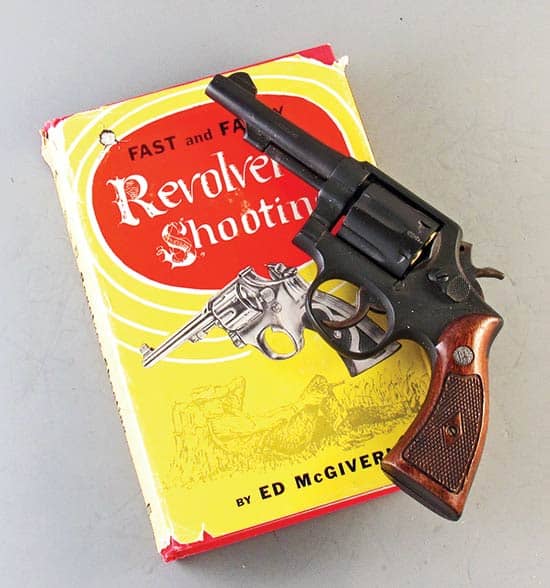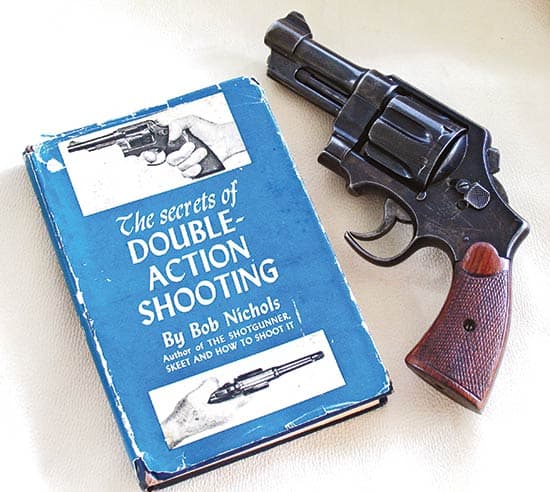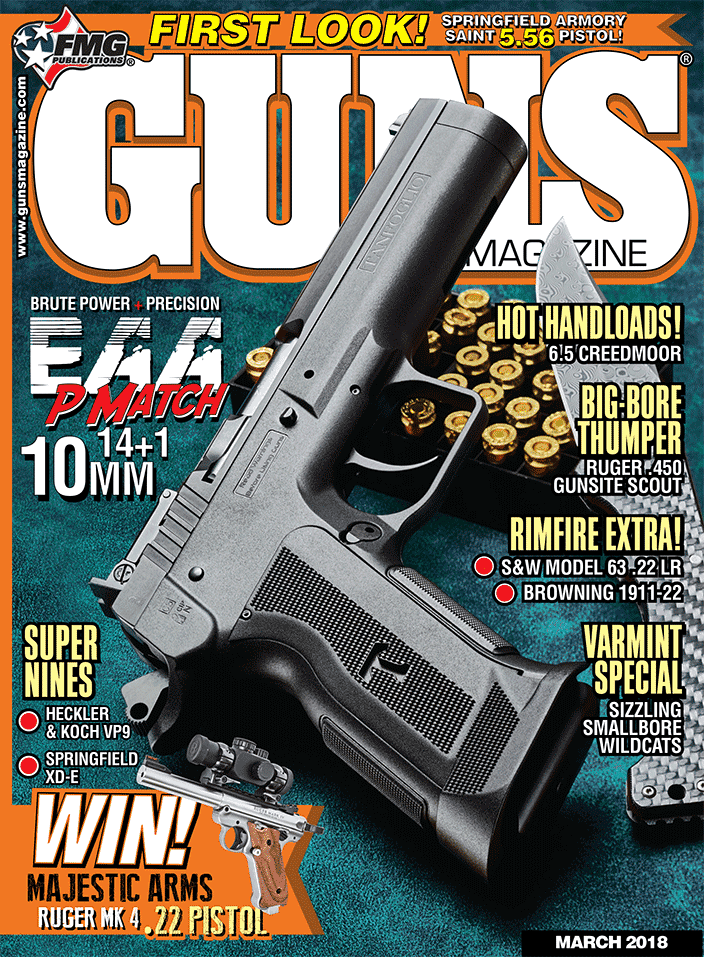Past Masters Of The Double-Action Sixgun
Part 8: Ed McGivern & Bob Nichols
During the last century, especially from the 1920s to the 1970s, the double-action sixgun was definitely the King. There were many men who raised the use of the double action to both a high art and science. These men need to be remembered for their contributions and with this in mind, we go back in history when six shots were the norm and all that was needed. All of these men are now gone. As a kid never did I ever imagine I would actually know many of these six gunners.
Ed McGivern, author of Fast and Fancy Revolver Shooting in 1938, is the fastest man with a double-action sixgun who ever lived, at least until modern times and the arrival of Jerry Miculek. Unlike Jerry, McGivern also used Single-Action Colts in his exhibition shooting and was unbelievably fast fanning the hammer and putting all five shots into the area of a playing card. McGivern’s book covers just about every aspect of shooting and especially speed shooting and long-range shooting. For the latter he used the then relatively new Smith & Wesson .357 Magnum on silhouette targets out to 600 yards.
Today we may think scopes on handguns are relatively new, however McGivern was scoping the Smith .357 Magnum in the 1930s. There were no long-eye-relief pistol scopes available way back then, so McGivern used a Lyman 438 Field Scope. Mounted on the barrel rib of the 8-3/4-inch .357 Magnum, this very long scope stuck out about 6 inches behind the grip frame of the .357. He also fitted the long-barreled S&W with rifle buttstocks to aid in shooting long-range.
McGivern On Magnums
In this day and age .357 Magnums are often pushed way to the back by all the other more powerful cartridges available. However, in the 1930s the .357 Magnum was a huge step forward. McGivern shows some of the experimental .357 Magnum cartridges using bullets designed by Phil Sharpe.
Speaking of the .357 Magnum McGivern said, “These Magnum revolvers, in barrel lengths from 3-1/2 inches up to 6-1/2 inches, have been thoroughly tried out on quick-draw work, aerial target shooting, and on slow deliberate target shooting. They have also given highly satisfactory results at both superspeed double-action shooting and deliberate double action on paper targets at various distances, as plenty of accompanying evidence will surely show…
“The .357 Magnum revolver, with its varied assortment of adaptable ammunition, fulfills all the requirements of the revolver line for the outdoorsman in relation to game shooting, either large or small, results that can be secured being entirely dependent on the skill and ability of the shooter, as has already been quite clearly demonstrated by several noted performers in this field… It is my candid opinion that there is no man living today who’s holding and trigger control, or for any number of shots ever will, equal the accuracy of the .357 Magnum or of the other high-grade target revolvers available today.” (Or, as I have often said I have yet to find the sixgun I can outshoot!)
Even before the advent of the .357 Magnum McGivern was using the .38/44 for long-range shooting and his book has targets pictured with all six shots on a silhouette target shot at 300 yards with iron sights. When it came to speed shooting his favorite sixgun was the S&W Military & Police .38 and his book shows several photographs with five shots which could be covered by the hand even though shot in 1/2 second. Using two guns, one in each hand, he performed the same feat on two targets in just over one second. His book is not the easiest reading, however, for pure sixgun information it is still valuable and a must read for any six gunner.
Bob Nichols
Bob Nichols was perhaps the foremost proponent of actually shooting double-action sixguns double action and is the author of The Secrets of Double Action Shooting (1950), perhaps the most in-depth study of actually using double-action sixguns ever written. Nichols was a contemporary of both Fitz and Ed McGivern and his book takes up where they left off. He used the Fitz Special modification, however, like McGivern, he preferred S&W revolvers. “Smith & Wesson actually did produce the first smooth and faultless doubleaction revolver ever made. The job took them all of 50 years to accomplish. The accomplishment came, however, when the perfect double-action revolver no longer seemed particularly important. The automatic was now in the saddle.”
So even as early as the 1940s the handwriting was already on the wall and the semi-auto would eventually be king for military and police, as well as many civilians. As the title of Nichols’ book says, this is about all aspects of real double-action shooting, using the trigger not the hammer to cock the action and it is worthwhile to note he talks of bull’s-eye shooters in the 1940s using their S&W Target revolvers in the double-action mode. This book is an absolute must-read for those who appreciate, and want to know more, about double-action shooting. It is interesting to note his observance that Fitz understood full well the S&W was better for double-action shooting than the Colt he—by necessity as an employee of Colt—had to use.
Speaking in 1950 Nichols said: “I would like to see thousands of our American pistolmen, and especially our cops and our soldiers, properly armed for deadlier double-action performance. As I have said, no coach is necessary to teach the deadly principle of double-action fire and alignment control. The standard-action Smith & Wesson double-action revolver itself will teach the pistolman double-action hitting; and teaching quicker, I sincerely believe, than single-cocking fire ever could be taught.
“One of the great advantages of double-action shooting is that it represents a single specialized technique. The double-action pistolman always shoots in the same double-action technique, whether on the bull’s-eye range, on moving or aerial targets, or in combat practice. Thus, using the one technique, the double-action pistolman steadily becomes a deadlier combat pistol man.”
Bob Nichols was a teacher pure and simple and his book is the best text ever written on pure double-action shooting. “A secret of McGivern’s double-action trigger control is steady and non-stop motion, first, catch the alignment relationship of the gun sights in the immediate region of the target, the point you will want to hit. Now begin your trigger pull—and once having started it, never stop. Never falter, either. Think of the steady movement of the pendulum on a metronome. Practice this double-action trigger pull slowly at first, s-l-o-w-l-y. Forget speed, make the trigger pull steady, non-faltering, and absolutely non-stop, once started—follow-through—never pause—never stop. At the fall of the hammer, let the trigger finger move forward at the same speed used in pulling the double-action trigger. Practice this in dry snapping for a week before using ammunition. Let your trigger finger become grooved to this timing interval. Thus your trigger finger gradually learns the steady back and forth non-stop movement of the metronome. This is simple, slow-fire beginning of the McGivern trigger control. When you go to practice with ammunition, be on guard against that ruinous pause, that indecisive faltering, or even that complete stop of the double action trigger pull!”
Nichols believed in complete double-action shooting including target shooting on bull’s-eyes. However, this works best with the old “long-action” S&W double-action sixguns. Nichols was very vocal about S&W dropping this time-proven action for the new short action in the 1950s. Finally, Nichols said: “I’d rather teach a beginner double-action shooting any time than try to teach him single-cocking pistol shooting. Double action is simply the easier way to shoot a pistol—and quicker to learn—and the faster and deadlier way with a pistol after you have learned the trick—though with, of course, only the standard-action Smith & Wesson double-action revolver—and also with the gun properly stocked with the Mershon Ten-Point grip, or its equivalent.”
Most of us probably approach shooting a double-action sixgun in just the opposite way recommended by Nichols. Our advancement would probably be much faster if we followed his old advice.







